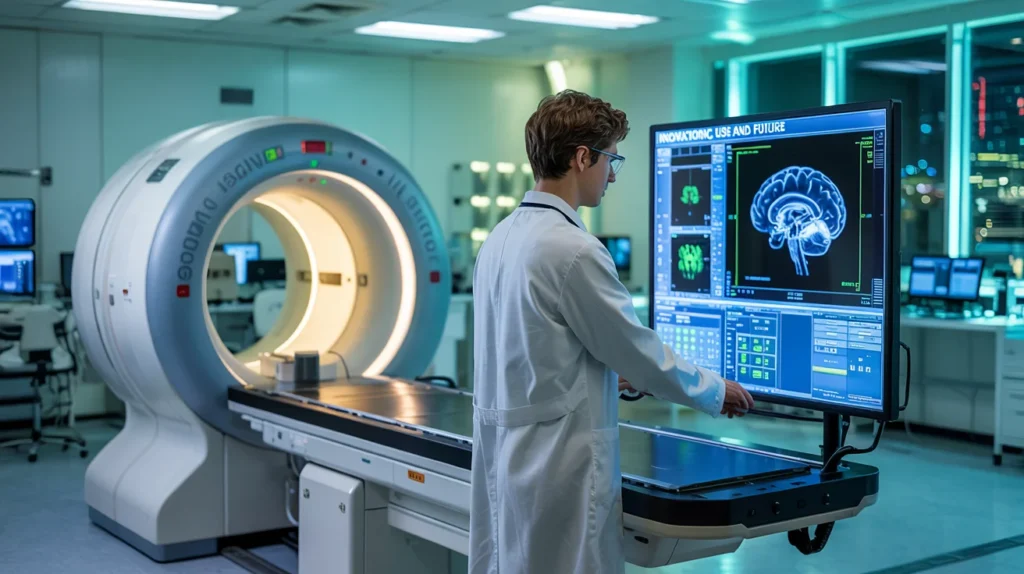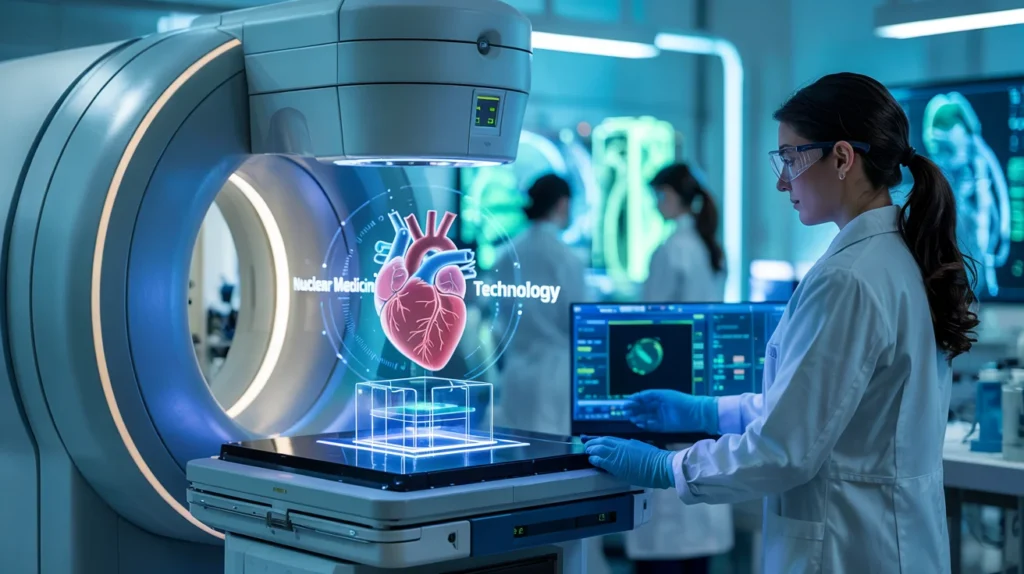Nuclear medicine technology is a modern branch of medical science. It combines physics, chemistry, and biology to create life-saving techniques. Doctors use it to diagnose diseases and treat complex health conditions. Unlike traditional scans, it provides clear images of body functions. Therefore, it has become a critical tool in healthcare.
This technology works with radioactive materials in very small amounts. These substances help identify diseases at an early stage. As a result, patients get treatment faster and with better outcomes. With time, nuclear medicine technology has changed from simple scans to advanced treatments. It is now one of the strongest weapons in modern hospitals.
Because it is non-invasive and accurate, the demand for nuclear medicine is rising. Hospitals, clinics, and research centers depend on it every day. Patients also benefit because it reduces pain, increases safety, and gives reliable results. Clearly, this medical innovation is shaping the future of healthcare.
The Evolution of Nuclear Diagnostic Technology
The story of Nuclear Diagnostic Technology began in the early 20th century. Scientists discovered radioactive isotopes and their effects on the human body. After World War II, this knowledge turned into medical applications. At first, it was limited to simple imaging. Later, it grew into complex procedures that combine therapy and diagnosis.
Today, this technology is no longer limited to research labs. It is available in hospitals around the world. The integration of digital imaging, artificial intelligence, and molecular biology has pushed it forward. Consequently, Radiopharmaceutical Technology is not just about identifying illness. It is also about providing personalized care for patients.
How Radiopharmaceutical Technology Works
Nuclear Diagnostic Technology uses radioactive tracers. These tracers are introduced into the body through injection, swallowing, or inhalation. Once inside, they move to specific organs. Special cameras then capture the signals they release. This process creates images of the body’s function rather than just its structure.
Doctors can then detect tumors, heart disease, or even brain disorders. Since it reveals problems at a cellular level, it is more powerful than many other imaging methods. In fact, nuclear medicine is often used before visible symptoms appear. This early detection saves time and lives.
Key Functions:
- Radioactive tracers highlight active disease areas
- Cameras capture organ functions in real time
- Doctors analyze cellular activity for early diagnosis
- Treatment can begin much earlier than with traditional scans
Benefits of Nuclear Diagnostic Technology

Nuclear Medical Imaging provides several important advantages for patients and healthcare providers. It makes early detection possible, reduces the need for invasive methods, and offers more personalized treatment options. By doing so, it improves accuracy in diagnosis while keeping safety a priority.
Detects Disease Before Symptoms Show
Nuclear Medical Imaging can identify illnesses at a very early stage, even before symptoms appear. This allows doctors to start treatment sooner, which improves recovery chances and prevents the disease from spreading further.
Helps Avoid Unnecessary Surgeries
By giving clear and accurate images of body functions, nuclear medicine reduces the need for exploratory surgeries. Patients benefit because they avoid painful and risky procedures while still receiving a precise diagnosis.
Provides Targeted Treatment Methods
This technology makes it possible to deliver treatment directly to the affected area of the body. As a result, healthy tissues are less exposed, and patients experience fewer side effects while getting better results.
Improves the Accuracy of Cancer Diagnosis
Cancer cells can be detected more clearly with nuclear medicine scans. These advanced images help doctors locate tumors, measure their size, and monitor how they respond to treatment, leading to more effective cancer care.
Increases Safety With Minimal Side Effects
Nuclear medicine uses very small amounts of radioactive material. The process is safe, carefully monitored, and usually painless. Patients experience minimal side effects while still gaining valuable information about their health.`
Role of Nuclear Medicine in Cancer Care
Radiopharmaceutical Technology plays a vital role in cancer care. It helps doctors detect tumors early, track how cancer spreads, and monitor patient responses to treatment. With this accuracy, therapies become more effective, and patients benefit from longer, healthier lives.
Key Feature:
- Locates tumors with high accuracy
- Detects even the smallest cancer cells
- Tracks how cancer spreads in the body
- Monitors response to ongoing treatment
- Helps adjust therapy plans quickly
Nuclear Medicine and Heart Health
Radiopharmaceutical Technology is an essential tool in cardiology. It provides detailed images of blood flow, heart muscle function, and blocked arteries. With this information, doctors can detect heart disease at an early stage and treat patients before serious complications occur.
In addition, stress tests combined with nuclear scans are highly effective. They allow doctors to evaluate how the heart performs under pressure, predict risks, and prevent major heart problems such as heart attacks. This makes nuclear medicine a powerful method for protecting heart health.
Future of Nuclear Diagnostic Technology
The future of Radiopharmaceutical Technology looks highly promising. Artificial intelligence is improving the way scans are interpreted, making results more accurate. At the same time, new tracers are being developed to detect diseases at earlier stages, while combined imaging systems like PET/MRI are transforming how doctors approach diagnosis.
Another major advancement is the shift toward precision medicine. This approach allows every patient to receive a treatment plan tailored to their specific needs. With these innovations, nuclear medicine will continue to become more personal, faster, and far more effective in improving patient care.
Challenges Facing Nuclear Medicine
Although Radiopharmaceutical Technology is highly effective, it also faces several challenges. The high cost of equipment and materials makes it difficult for many hospitals to adopt. There is also a shortage of trained professionals to handle the advanced systems. In addition, strict safety protocols must always be followed to ensure the protection of both patients and staff.
Issues:
- High cost of equipment and materials
- Shortage of skilled professionals
- Strict safety protocols required
- Limited access in smaller hospitals
- Need for continuous training and updates
Applications Beyond Healthcare
Nuclear Diagnostic Technology extends its role beyond hospitals and clinical use. It is widely applied in research fields such as biology and chemistry, where it helps scientists explore how the human body works at a deeper level.
One major application is in drug development. By studying how medicines move through the body, researchers can design safer and more effective treatments. This improves the quality of therapies before they reach patients.
It is also a valuable tool in neurological studies. Advanced brain imaging offers insights into conditions like Alzheimer’s and Parkinson’s disease. These findings guide the creation of new treatments and expand scientific understanding of the brain.
Conclusion
Nuclear medicine technology has changed the way doctors diagnose and treat disease. It provides early detection, accurate imaging, and safe methods that improve patient outcomes. By combining science and innovation, it has become one of the strongest tools in modern healthcare.
The field continues to evolve with the help of artificial intelligence, advanced tracers, and precision medicine. These improvements make diagnosis faster, treatment more targeted, and results more reliable. As a result, both doctors and patients benefit from greater confidence in medical care.
Looking ahead, Nuclear Medical Imaging will only grow in importance. Despite challenges like cost and training, its potential is limitless. With continuous research and development, it will remain at the center of healthcare innovation, saving lives and shaping the future of medicine.

